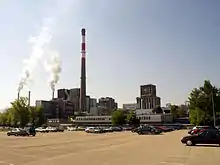Lenzing AG
The Lenzing Group is an international group with its headquarters in Lenzing, Austria, and production sites in all major markets.[3] Lenzing produces wood-based viscose fibers, modal fibers, lyocell fibers and filament yarn, which are used in the textile industry - in clothing, home textiles and technical textiles - as well as in the nonwovens industry. In addition, the company is active in mechanical and plant engineering. TENCEL™, VEOCEL, ECOVERO, LYOCEL and LENZING are Lenzing's product brands.[4]
 | |
| Type | Aktiengesellschaft |
|---|---|
| WBAG: LNZ | |
| Industry | Chemicals |
| Founded | 1938 (Zellwolle Lenzing AG) |
| Headquarters | Lenzing, Austria |
Key people | Stefan Doboczky (CEO), Hanno Bästlein (Chairman of the supervisory board) |
| Products | Textile fibers, nonwoven fabrics, pulp, thermoplastics, PTFE, acrylic fibers |
| Revenue | €2.26 billion (2017)[1] |
| €371.0 million (2017)[2] | |
| €281.7 million (2017)[2] | |
| Total assets | €2,497.3 billion (end 2017)[2] |
| Total equity | €1,527.7 million (end 2017)[2] |
Number of employees | 6,488 (end 2017)[2] |
| Website | www.lenzing.com |
History
The company initially focused solely on fiber production, but it needed plastic wrappings for its fiber bales, so Lenzing Plastics was founded to produce them. The plastics division is still active, making 11.7% of total sales in 2009.[5]

The company's history goes back to 1892 when Emil Hamburger, an industrialist, operated a paper mill in Lenzing, Austria. In 1938 Zellwolle Lenzing AG was founded, starting pulp and viscose fiber production and in 1962 the company's name was changed to Chemiefaser Lenzing AG. The old calcium bisulphite method was used for fiber production until 1963, when the new more eco-friendly magnesium bisulphite method was introduced. In 1975 the company established a department responsible for the environment and introduced a more "green" bleaching process for pulp in 1977. In 1984 the company name changed to Lenzing AG and its shares were listed on the Vienna Stock Exchange in 1986.[6]
Lenzing Group has international branch offices in the United States and Asia (China, India, Indonesia). Its production facilities are located mainly within the European Union, with the fibers being produced in Austria, United Kingdom, the US, China, and Indonesia, and starting a production facility in Thailand by 2022.while its plastics factories are located in Austria, Germany, the Czech Republic, and the US. The pulp is produced in the [[Czech Republic] and Brazil ] and the engineering research is done in Lenzing, Austria which is also the largest integrated pulp and viscose fiber production site worldwide.[7]
Total 2009 sales were EUR 1.25 billion, with a workforce of 6,021. The main fiber markets of Lenzing are Asia (52%) and Europe (39%). The majority owner of Lenzing, with 90.15% of voting rights, is B & C Industrieholding GmbH along with its subsidiaries.[5] As of 2007, the corporate group has an annual production of over 500,000 tons of fibers, over 27,000 tons of plastics, and over 80,000 tons of paper.[8] The paper division was sold out in 2008.[9]
In April 2015, Lenzing sold its German subsidiary Dolan, along with Kelheim and a 91-percent stake in European Carbon Fiber GmbH to WHEB Partners' Growth Fund 2 and Jan Verdenhalven. The sale price remains confidential.[10]
References
- "Annual Report 2017" (PDF). Lenzing. Retrieved 22 March 2017.
- "Lenzing Group". www.lenzing.com. Retrieved 2018-05-24.
- "Lenzing Group". www.lenzing.com. Retrieved 2018-05-24.
- "Archived copy". Archived from the original on 2009-10-29. Retrieved 2010-10-30.CS1 maint: archived copy as title (link)
- "Archived copy". Archived from the original on 2010-08-30. Retrieved 2010-10-30.CS1 maint: archived copy as title (link)
- "Archived copy". Archived from the original on 2009-09-25. Retrieved 2010-10-30.CS1 maint: archived copy as title (link)
- http://www.lenzing.com/sites/gb07/english/html/1.htm
- http://www.lenzing.com/sites/gb07/english/html/1_1.htm
- "Archived copy". Archived from the original on 2015-04-19. Retrieved 2015-04-16.CS1 maint: archived copy as title (link)
External links
| Wikimedia Commons has media related to Lenzing AG. |
- Official website (in English)
- Vienna Stock Exchange: Lenzing AG
